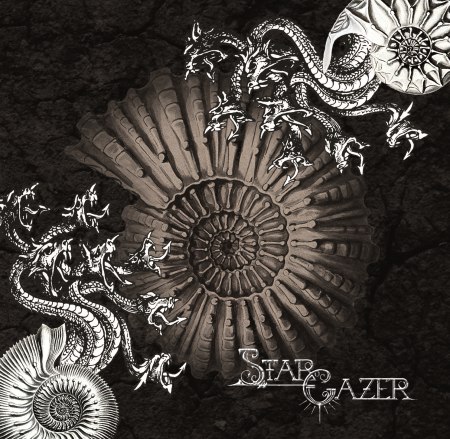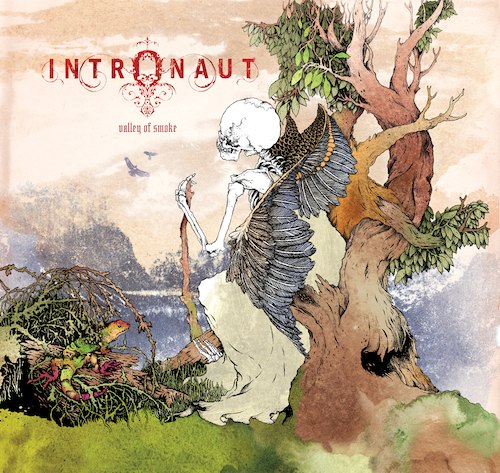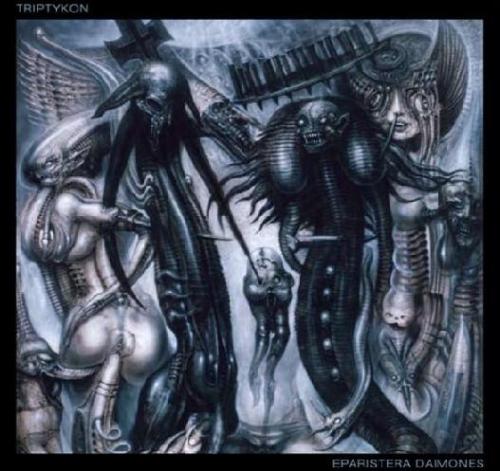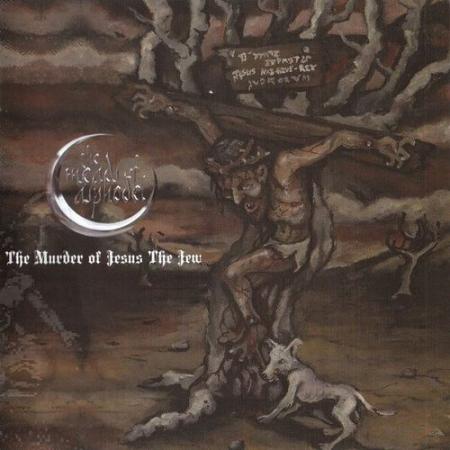Alright, friends – things are starting to get a bit heavy around here as we continue counting down the year’s best metal albums. Spinal Tapdance presents here, for your viewing (dis)pleasure, the second of three installments ticking off the 30 best records from across the vast universe of heavy metal. Let us know where we’ve nailed it, and where we’ve completely fucked up and made you embarrassed to have ever even considered directing your web browser to this sad, shabby piece of disagreeable trash we call a blog.
—————————-
20. StarGazer, A Great Work Of Ages/A Work Of Great Ages
In my review of StarGazer‘s sophomore album, I called A Great Work Of Ages “a seething, lurching, yet surprisingly sprightly beast of a musical journey that assaults the unsuspecting passer-by with dauntingly technical instrumentation that nevertheless resolves into a measured, artfully-meted out accounting of chaos.” Thing is, that mouthful of overwrought prose makes this album sound like a chore to listen to, which it most definitely (and defiantly) is not. There’s plenty of off-kilter structure and inventive musicianship to admire and analyze throughout this progressive/technical death metal head-trip, but first and foremost, this is an album to put on, sit back, and just enjoy. You won’t be singing any choruses or humming along to a repeated bridge, but you will be amazed at the ability of these Aussies to play the shit out of their instruments without overwhelming the listener in a blitzkrieg of claustrophobic production and impenetrable gestures.
19. Intronaut, Valley Of Smoke
Something about Intronaut had never quite jived with me until this album, but boy does Valley Of Smoke set me right and kick me in my ass for doubting it. These songs are fluid compositions with impressive range, and despite the increasing prominence of clean vocals and smoothed-out texture, this ain’t no soft-ball half-metal nonsense. It’s all about finding the right groove and sucking you down into its beguiling depths, down into that great colorful panorama of the album’s cover – whether you are the skeleton, or the iguana, or the loftily-soaring eagles is your own concern. Valley Of Smoke injects jazz-fusion into rumbly post-metal’s environs, and comes out the other side smelling of roses and roses and roses.
18. Kvelertak, Kvelertak
Kvelertak’s self-titled debut album is the 2010 equivalent of last year’s phenomenal Darkness Come Alive by Doomriders. Meaning, this is a gnarly collision of all sorts of ass-kicking, party-inducing music. You can quibble all you like about whether it’s punk, hardcore, black metal, garage rock, and anything else, but the undeniable fact is that this is just music for an all-around good time. I simply cannot fathom the ridiculous backlash against this band, because every time I throw on this album, I just want to drink some beers and jump around in a forest on a pogo stick. I mean, come ON, doesn’t that sound fucking awesome? Sure, the dudes have got a jokey take on Scandinavian mythology, but honestly, if you’re sitting in a library poring over your Eddas and Kalevalas and waxing poetic about Yggdrasil while frowning at the hooligans making noise in the corridor… Well, friend, maybe it’s time to hand in your heavy metal ID card.
17. Nechochwen, Azimuths To The Otherworld
This Nechochwen album was one of the most pleasant surprises I had all year. Apparently they’ve got one other album besides this one which leans more toward the neo-folk side of things, but Azimuths to the Otherworld, apart from having one of the coolest album titles of the year, strikes a satisfying balance between folky acoustic bits and rich, driving black metal. The fact that the band pays tribute to the beliefs and histories of American Indians is a refreshing aesthetic, and makes for some different types musical influence showing themselves throughout the album, much like on Tomahawk’s Anonymous album. The out-and-out metal sections are still relatively few and far between, but the album is all about mood, and the insistent drumming and beautiful acoustic guitar work throughout sustains a very contemplative atmosphere. Don’t miss out on this one.
16. Triptykon, Eparistera Daimones
So intense has been the drama surrounding Celtic Frost’s demise, and rebirth, and subsequent re-burial, that one could be forgiven for worrying that the next project of these metal giants would perish under the weight of self-doubt and ridiculous expectations. But have no fear, friends, for Eparistera Daimones is more than ample proof that Tom G. Warrior is one of heavy metal’s original, and still greatest, alchemists, transmuting sturdy, solid riffs into tortured tales of harrowing emotional journeys. Just as was Celtic Frost’s Monotheist, Triptykon’s debut is a dark, exhausting listen, but one from which the listener emerges feeling revitalized, having survived the trial by fire of some of the bleakest, most Gothic moments the Warrior has yet thrown her way.
15. Atlantean Kodex, The Golden Bough
Everything about this album screams ‘epic’. Perhaps the best thing about Atlantean Kodex’s long-awaited debut album is that one can approach it from a wide range of starting points: from the epic trad metal of Manowar, from the triumphant Viking era of Bathory, from the pagan/black wizardry of Primordial, or from the true doom of Reverend Bizarre. Take any of these avenues of approach, and you’ll find The Golden Bough waiting for you, patient, resolute, and steadfast. These are songs in no hurry to get you anywhere other than right in the midst of their stately riffing and clear-voiced hymns to the myths from which we all spring.
14. Unearthly Trance, V
Unearthly Trance’s fifth album (V, get it?) is another of those that took its time with me. Far less direct than the band’s previous two (and decidedly more Frost-y) albums, V is an all-encompassing listen that honestly sounds like a planet being slowly torn apart by silent electric storms. Sounds pretty great, right? The dual vocal attack of longtime bandleader Ryan Lipynsky and drummer Darren Verni drags bile up from the depths of a city’s fetid sewer system, while riffs lumber in and decay just as soon as they’ve announced themselves. A much more abstract style of nihilistic doom, which actually gels rather neatly with the occult slant of the lyrics. Take your time with this album, or it will take its time devouring you. Or will do so either way. Whatever; doom on.
13. Slough Feg, The Animal Spirits
If I had the luxury of titling this album myself, I probably would have called it “So Many Smiles.” Because, honestly, it’s hard to imagine any fan of classic heavy metal not hearing this album and getting a giant, daffy grin plastered all over her face. I don’t mean to say that this album is lightweight and unserious, but it knows how to be serious without taking itself seriously, if that makes any sense. If that doesn’t make sense, well, there’s a whole fistful of songs here to make all the sense that my stupid words can’t: “The 95 Thesis,” “Kon-Tiki,” “Free Market Barbarian,” “Ask the Casket” – these are honestly some of the best, most memorable, and freshest sounding heavy metal songs I’ve come across in ages. So, seriously, whatchu waiting for? Get your Slough Feg on, and get your smiles on. Sooooooo many smiles.
12. The Meads Of Asphodel, The Murder Of Jesus The Jew
Okay, now here’s a band that probably takes itself too seriously. Sorry, dudes, but it’s the truth. Have you read Metatron’s 60,000-word codex? Have I? I think we all know the answer to both those questions, friends. Thing is, no matter how seriously these English blokes take the lyrical subject matter of this concept album which purports to set the historical record straight, mercifully their music is every bit as chaotic and mind-exploding as ever. Perhaps more so, if it comes down to it. There’s a little bit of everything thrown in here, though the main strands remain a peculiarly English-smelling bit of crusty punkiness, Hawkwind psych and Floydian prog, plus symphonic black metal with a capital Sigh. Sounds like a mess, innit? Well, it works. At times beautifully. If you ain’t know the Meads, you ain’t know shit about freak-folk’s distant cousin in medieval black metal played by dudes in chainmail.
11. Deathspell Omega, Paracletus

Speaking of dudes taking themselves too seriously… Well, it actually doesn’t bother me with Deathspell Omega. Completing a supposed trilogy of Lord knows what esoteric and orthodox black metal themes, all that’s ever mattered about this band, to this listener, is the music. And on that score, I’m chuffed as all shit to report that Paracletus may even best Fas…, if not quite ascending to the madness-provoking heights of DsO’s breakthrough album, Si Monumentum Requires, Circumspice. Paracletus whittles the excesses of previous albums down to a concise 40-ish minutes, over the course of which the listener is plunged into a disorienting maelstorm of churning riffage and refracted shards of black prismatic light. The guitars are clean and razor-sharp, but what really stood out to me in this album is the great diversity of vocal styles by whoever the fuck in this band does vocals. There’s the traditional black groan/shriek, but also some clean vocals tossed in, as well as some more gut-level bellowing. Oof. Great, powerful, genre-damning stuff. Stare into their abyss, ye who dare.
————————————————————–
I can hear you all out there, licking your chops for the third and final installment of Spinal Tapdance’s extravagant end of 2010 recitations. Be patient, gentlefolk, and while you’re at it, how am I doing so far? Anything egregiously left off the list so far? Any predictions for the top ten? Anyone out there find their way to this site, thinking it was some snarky alternative-style tapdancing academy, and now becoming more and more enraged at the incessant talk of things like “riffs” and “metal” and “things and people being taken not enough or too seriously”? I can hear you too, you shiny, clackety-shoed mouthbreathers.




























































